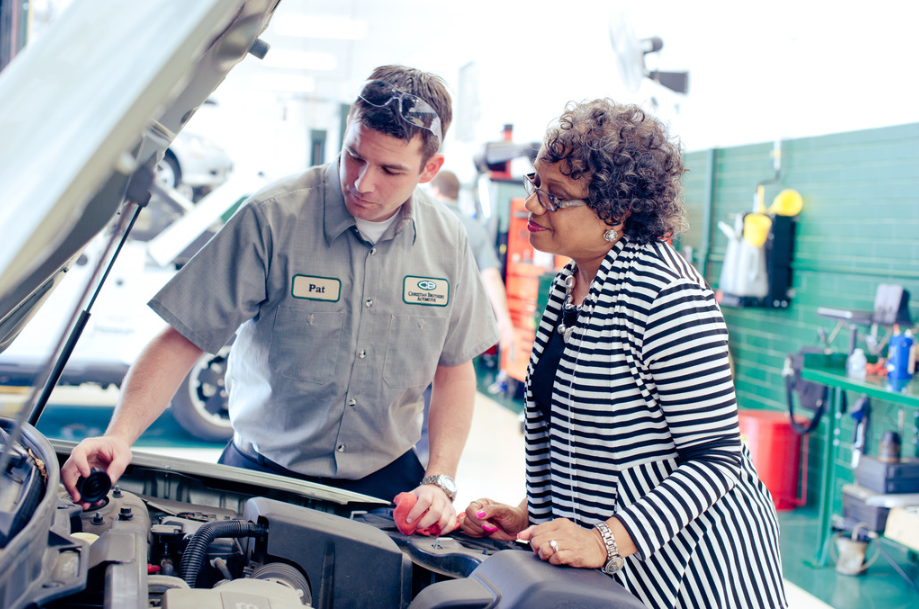Four Alarming Signs of a Radiator Leak

There are many essential components for your car's internal mechanisms, but none are as paramount as itscooling system. Out of four core elements that make up a vehicle's cooling system – radiator, coolant, water pump, and thermostat – the radiator takes center stage in regulating your vehicle's temperature levels. Without it, your engine would certainly overheat!
In this blog, the expert technicians at Christian Brothers Automotive will explain how a radiator works, provide signs that it's leaking, and offer recommendations on what you can do about it. With this knowledge, we hope you can better understand this important engine part and take steps to avoid major problems with your car's cooling system.
How Does a Car Radiator Work?
Before we discuss the signs that reveal your radiator is leaking fluid, it's important to break down why there is a fluid that needs to be cooled in the first place.
An internal combustion engine, whether a gasoline or diesel engine, creates a lot of heat during combustion. To keep your engine from burning up and seizing, it’s important to move this heat away from the engine. This is done through the car's cooling system.
At the heart of this process lies your car’s radiator, which helps move heat away from the engine and cool it down. It does this by using a liquid coolant – usually a mixture of antifreeze and water – to absorb the heat from your engine and carry it away, releasing it in the form of steam (or hot air) through the radiator. In short, it absorbs the heat from your engine and radiates that heat outside the engine. This is how your engine’s temperature is regulated.
Now that you can see the importance of coolant and why a leak would be detrimental, we want to make sure you are able to identify a radiator leak, so you can prevent your engine from overheating.
How to Identify a Radiator Leak
Coolant leakage is a typical issue with radiators, generally arising from a defective radiator cap, split radiator hose, corrosion due to age, or even a puncture from debris on the road. Although the average lifespan of car radiators ranges between 8-10 years, the lifespan of your car’s radiator depends on your servicing habits and the quality of coolants you use. Truthfully, though, even with proper servicing with quality coolant, a leak can still develop at any time, and if coolant levels drop too low, you could face serious engine damage and a car that won’t make it much longer. Alright, then…let’s train you to spot a leak!
Like a detective, let’s look for evidence of a leaky radiator.
Exhibit A: Large Drop in Coolant Level
A large drop in coolant level is a major sign that your radiator is leaking. If you notice the coolant level falling, either by checking it yourself or by having it checked at least twice a year as part of your regular car maintenance, this could indicate that your radiator is leaking.
Coolant levels slowly drop over time, but if there’s a radiator leak you will probably notice a drastic drop in coolant levels. Additional coolant can be added to the reservoir, but it’s important to repair the leak as soon as possible.
Exhibit B: Gradually Rising Temperature Gauge
Typically located next to your fuel gauge, your engine’s temperature gauge may start rising quickly and consistently higher and higher as you drive if there’s a radiator leak. When this happens, it signifies your engine is starting to overheat. There will likely be a drop in the coolant level, so inspecting your reservoir right away is a good idea. Whatever the case may be, it’s best to consult a professional technician who can diagnose your radiator leak and rule out any other engine problems.
Exhibit C: Visible Discolorations or Corrosion
A normal radiator should look clean and free of any visible corrosion. If you see discolorations or corrosion on your radiator or elsewhere nearby, the evidence is pointing to a leaky radiator.
The spots you'll notice are caused by the coolant spraying out. These leaks can cause corrosion to nearby components such as hoses and other metal parts, speeding up leaks and other weak points around the radiator. If this happens, you can minimize additional damage by washing the affected areas with water and then taking your vehicle to your local auto repair shop for help as soon as possible.
Exhibit D: Puddles Underneath the Engine
Similar to other leaks, you may notice a puddle of liquid (usually green or lime in color) underneath your car, specifically towards the engine block. Your coolant may be a different color, but they are all slimy and brightly colored to tell the difference from other vehicle fluids.
Clean it up immediately if you spot a leak because it is very toxic.
If you’ve done your detective work and if the evidence points to a radiator leak, we have a few recommendations for what you can do to fix the leak.
How to Fix a Radiator Leak
There are a handful of possible solutions for a radiator leak, including:
Tightening your radiator cap
Replacing your radiator cap
Replacing damaged hose connections
Replacing cracked/broken hoses
Replacing the radiator
It's best to have a certified technician handle these repairs for you since it can require a professional inspection to locate the exact cause of the leak in the first place and certain expertise to get the job done right.
Christian Brothers Automotive is Here for Your Radiator Troubles
Turn to Christian Brothers Automotive for help identifying and repairing your radiator leak or other cooling system issues. Our experienced technicians will inspect your radiator and other cooling system components, diagnose the problem, and recommend a solution that’ll get you back on the road in no time! We take pride in our superior workmanship and offer reliable repairs and services at honest rates. If your radiator needs a repair or tune-up, find your local Christian Brothers Automotive location to fix the problem today!
This blog was written in July, 2016, and was updated in August, 2023, to reflect current industry standards and best practices.


[1].jpg)
Sunwash-Tech-with-Customer.jpg)

